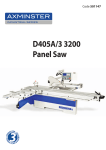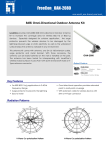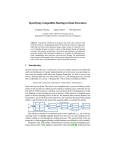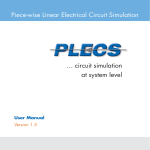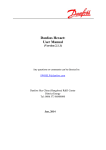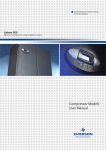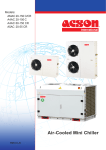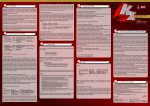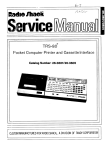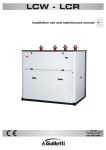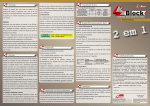Download Chapter 4 Kaori BPHE User Manual
Transcript
Chapter 4 User Manual BRAZED PLATE HEAT EXCHANGER User Manual CONTENTS 1. Working Principle 2. Application 3. Advantage 4. Specification & BPHE Dimension 5. Design Condition for Copper Brazed PHE 6. Standardized Connections 7. Installation Guide 8. Anti-Freezing Protection Methods for BPHE 9. Soldering Instruction 10. Cleaning 11. Warning 12. Warranty Terms 4-1 1. Working Principle Kaori’s Brazed Plate Heat Exchanger (BPHE) consists of chevron plates of acid-resistant stainless steel. Every other plate is reversed so the ridges of the herringbone pattern intersect one another on adjacent plates forming a lattice on contact points. When these points are vacuum brazed together, two separate systems of channels for two media flow in counter-current are formed. The lattice structure causes vigorous turbulence, thus ensuring maximum heat transfer. The BPHE is a highly efficient, corrosion-resistant, and pressure-resistant heat exchanger. The standard BPHE is designed to meet 30 bar, 200℃, with the largest model capable of handling a maximum flow capacity of 900 liter/min. 4-2 2. Application Kaori BPHE can be used for various mediums such as: - All type of refrigerants - Nickel brazed models used for Ammonia - Organic solvents - Water - Oil - Various brine solutions (glycol mixtures, CaCl2, alcohols etc) Kaori BPHE can be used in: - Heat pumps - Industrial chiller; plastic machines, welding machines, hydraulic presses (oil), and compressor oil cooling - Air conditioning - Refrigeration - Air dryer - Water cooler; drinking water or process water for various industries - Temperature holding for storage tanks - Heat recovery including heat recycling from hot steam - Indoor heating including floor heating Refrigerant applications, BPHE function as: - Evaporators - Condensers - Super-heaters for gas - Desuper-heaters for gas - Subcoolers for condensate - Economizers - Intercoolers - Oil coolers 3. Advantages Kaori BPHE provides many advantages such as: - Highly thermal efficiency - Compact in size and light weight - High allowable working pressure - High thermal resistances and high operating temperature - Lower cost for the same performances - Lower pressure drop and high corrosion resistance - No gaskets required therefore no leakages - Easy installation, easy replacement with less maintenance - Durability 4-3 4.Specification & BPHE Dimension Type L1 L2 W1 W2 Weight mm mm mm mm Kg 205 172 73 42 0.81+0.04(N-1) Thickness (H)mm Area Volume M2/plate Liter/Channel Max NO. of plate 8+2.27(N-1) 0.012 0.025 60 K025F×A 206.2 172 74.2 40 0.3+0.044(N-2) 11+2.25(N-2) 0.012 0.025 60 K025F×B 206.2 172 74.2 42 0.3+0.044(N-2) 11+2.25(N-2) 0.012 0.025 60 K025F 40 0.8+0.05N 10+2.25N 0.0117 0.025 60 K030E 194.5 154 80.5 40 0.3+0.045N 7+2.25N 0.0117 0.025 60 K030 194 154 80 K030S 194 154 80 40 1.2+0.05N 12+2.25N 0.0117 0.025 60 K040 311 278 73 40 0.84+0.07N 10+2.3N 0.01946 0.040 60 K040E 311 278 73 40 0.68+0.07N 9+2.3N 0.01946 0.040 60 K040S 311 278 73 40 1.3+0.07N 12+2.3N 0.01946 0.040 60 K050 306 250 106 50 1.5+0.135N 10+2.4N 0.0255 0.055 100 K050S 306 250 106 50 2.2+0.15N 12+2.4N 0.0255 0.055 100 K070 304 250 124 70 1.6+0.15N 10+2.4N 0.03 0.065 100 K070S 304 250 124 70 2.5+0.17N 12+2.4N 0.03 0.065 120 K095 522 466 106 50 3.1+0.22N 10+2.4N 0.0475 0.095 100 K095S 522 466 106 50 5.0+0.24N 13+2.4N 0.0475 0.095 100 K105 504 444 124 64 3.5+0.24N 10+2.4N 0.0533 0.107 120 K105S 504 444 124 64 6.2+0.27N 13+2.4N 0.0533 0.107 120 K200H 613 519 186 92 7.12+0.41N 14+2.4N 0.09446 0.206 160 K200L 613 519 186 92 7.12+0.41N 14+2.4N 0.09446 0.206 160 K200M 613 519 186 92 7.12+0.41N 14+2.4N 0.09446 0.206 160 K200S 613 519 186 92 11.88+0.47N 17+2.4N 0.09446 0.206 160 K200E 613 519 186 92 1.84+0.4N 11.5+2.4N 0.09446 0.206 160 K205 528 456 246 174 7.2+0.52N 11.5+2.4N 0.1099 0.232 200 K205S 528 456 246 174 12.9+0.59N 14.5+2.4N 0.1099 0.232 190 K210 527 430 245 148 8.5+0.490N 11+2.85N 0.1036 0.289 200 K215 529 449 247 167 7.2+0.52N 13+2.4N 0.11 0.22 200 K215D 529 449 247 167 7.2+0.52N 13+2.4N 0.11 0.22 200 K215S 529 449 247 167 13.1+0.52N 16+2.4N 0.11 0.22 200 K040C 314 275 76 40 1.98+0.137N 13+2.0N 0.01925 0.0295 60 K040C×A 314 275 76 40 2.02+0.124N 13+2.0N 0.01925 0.0295 60 K040C×B 314 275 76 40 2.06+0.124N 13+2.0N 0.01925 0.0295 60 524 466 108 50 5.0+0.37N 13.2+2.16N 0.0475 0.071 120 K095C×A 524 466 108 50 5.1+0.32N 13.2+2.16N 0.0475 0.071 120 K095C×B 524 466 108 50 5.2+0.32N 13.2+2.16N 0.0475 0.071 120 K095C 4-4 5.Design Condition for Copper Brazed PHE Type K025F×A,K025F×B K030E,K040E,K200E K210 Max. working Pressure Test Pressure Max. working Temperature 10 Bar 15 Bar –160~+200℃ 16 Bar 23 Bar –160~+200℃ 30 Bar 43 Bar –160~+200℃ 30 Bar 43 Bar –160~+200℃ 45 Bar 65 Bar –160~+200℃ Max. working Pressure Test Pressure Max. working Temperature K025F,K030,K040 K050,K070,K095 K105,K200H,K200L K200M,K205,K215 K215D K215S K030S,K040S,K050S K070S,K095S,K105S K200S,K205S Type Side 1 Side 2 Side 1 Side 2 K040C,K095C 140 Bar 30 Bar 200 Bar 43 Bar –160~+200℃ K040C×A,K095C×A 70 Bar 30 Bar 100 Bar 43 Bar –160~+200℃ K095C×B,K095C×B 100 Bar 30 Bar 143 Bar 43 Bar –160~+200℃ 4-5 6.Standardized Connections *Connections for fluid applications are threaded connectors. *Connections for refrigerant units are soldered/sweat connectors. Threaded Connections Type PT/NPT/GB – Male 1/2" K025F K030 K040 K050 K070 K095 K105 K200 K205 K210 K215 ※ ※ ※ ※ ※ ※ ※ 3/4" ※ ※ ※ ※ ※ ※ 1" ※ ※ ※ ※ ※ ※ 1-1/4" 1-1/2" 2" PT/NPT/G – Female 2-1/2" ※ ※ ※ ※ ※ ※ ※ ※ ※ ※ ※ ※ ※ ※ ※ ※ ※ 3" 1/2" ※ ※ ※ ※ ※ ※ ※ ※ ※ ※ ※ 3/4" ※ ※ ※ ※ ※ ※ 1" ※ ※ ※ ※ ※ ※ 1-1/4" 1-1/2” ※ ※ ※ ※ ※ ※ 2" 2-1/2" ※ ※ ※ Soldered Connections Type K025F K030 K040 K050 K070 K095 K105 K200 K205 K210 K215 1/4” ψ6.60 ㎜ ※ ※ ※ ※ ※ ※ ※ 3/8” 1/2” 5/8” 3/4” 7/8” 1” 1-1/8” 1-3/8” 1-5/8” 2-1/8” ψ9.73 ψ12.90 ψ16.15 ψ19.25 ψ22.36 ψ25.60 ψ28.80 ψ35.25 ψ41.50 ψ54.30 ㎜ ㎜ ㎜ ㎜ ㎜ ㎜ ㎜ ㎜ ㎜ ㎜ ※ ※ ※ ※ ※ ※ ※ ※ ※ ※ ※ ※ ※ ※ ※ ※ ※ ※ ※ ※ ※ ※ ※ ※ ※ ※ ※ ※ ※ ※ ※ ※ ※ ※ ※ ※ ※ ※ ※ ※ ※ ※ ※ ※ ※ ※ ※ ※ ※ ※ ※ ※ ※ ※ ※ ※ ※ ※ ※ ※ ※ ※ Threaded Connections ※ ※ ※ ※ ※ ※ ※ ※ Soldered Connections 4-6 ※ 7. Installation Guide Illustration of 1:General purpose of BPHE 2:Types of fluid applied 3:Arrangements of fluids directions Application Fluid 1 Fluid 2 Evaporator (single refrigerant) Evaporator (dual refrigerant) Refrigerant A2→A1 Refrigerant 1 A2→A1 Refrigerant A1→A2 Cold water A2→A1 Cooling water A2→A1 Refrigerant A2→A1 Oil A2→A1 Chiller water B1→B2 Chiller water B1→B2 Cooling water B2→B1 Hot water B1→B2 Oil B1→B2 Condenser Heating,Cooling Oil cooler Air Dryer (Refrigerant) Air&Oil cooling (Air compressor) Fluid 3 Refrigerant 2 C2→C1 Air D2→(D1)→(B1) →B2→Separator→C1→C2 Cooling water D2→(D1)→(B1) →B2 Air C1→C2 ※Always install your BPHE vertically especially for a refrigerant system. This is done to secure the BPHE and keep minimum amount of water below the connector. ※In order to achieve high thermal efficiency and high heat transfer rates, BPHE has to be installed in a counter flow direction. 4-7 ※When BPHE works as an Evaporator, the two-phased (liquid an gas) refrigerant enters the evaporator at the bottom left connector and the single-phased (gas) refrigerant leaves the evaporator from the top left connector after the heat transfer process. The water enters at the top right connector and leaves from the bottom right. In the case of evaporator, heat is transferred from water to refrigerant and both fluids are in counter flow direction. ※When BPHE works as a condenser, the single-phased (gas) refrigerant enters the condenser at top left connector and the single-phased (liquid) refrigerant leaves the condenser from the bottom left connector. The water enters the condenser at bottom right and leaves the condenser from top right. In the case of condenser, heat is transferred from refrigerant to water and both fluids are in counter flow direction. ※Mounting suggestions: There are four different ways to mount the BPHE: (a) Bottom support (b) Sheet metal bracket, (c) Crossbar& bolts, (d) Stud bolts -All items should be supported independently. -Do not apply excessive forces to the fittings. -Except for small sized K030 model, our BPHE cannot be fastened directly to the fittings/piping. -Using flexible hoses or vibration dampers to reduce pulsation, shock or vibrations that are caused by the operating system. 4-8 8. Anti-Freezing Protection Methods for BPHE: Any formation of freezing or icing will damage BPHE and the refrigeration system. The following methods will prevent BPHE from freezing: -Use brine (e.g. glycol) when evaporation temperature is close to the freezing point. -Low working pressure will cause low evaporation temperature. If the evaporation temperature is below 0℃, it will cause water to freeze. Since the bottom portion has the lowest temperature, it is the most likely spot for the BPHE to crack. -To start the refrigeration system, always start the water pump for a few minutes and then start the compressor. To stop the system, always stop the compressor first and then stop the water pump. (1) Low Pressure Cut-off Switch (LP) A low-pressure cut-off switch should be installed with properly set values. When the actual evaporation pressure is lower than the setting value, the compressor will be cut off automatically. (2) Low Temperature Thermostat (LT) The function of the thermostat is to prevent evaporation temperature going under 0℃. If evaporation temperature is always above 0℃; then water has no chance to freeze and expand. (3) Water Temperature Sensor Installation of an anti-freezing temperature sensor near the water outlet is another method to prevent the water from freezing. The setting temperature is suggested at 4℃ for buffering purposes. (4) Water Flow Switch Installation of a water flow switch in the water circuit can prevent possible BPHE freezing up due to low water flow rate. Usually, low water flow rate may be caused by malfunction of water pump, leaking pipes, pipe blockage due to pipe contamination or dirty filter. 4-9 9. Soldering Instruction Cleaning and degreasing the surface of copper pipes and PHE connectors before soldering is important. To avoid the inside of copper pipes and BPHE from oxidation, protect the inside with N2-gas. Place the BPHE on a flat surface and wrap a wet rag around the connectors to protect the BPHE from excessive heating. Use a 40~45% silver alloy soldering rod to weld the copper pipe into the connector at a maximum temperature of 800℃. After soldering, clean and dry the connection and BPHE. 10. Cleaning Cleaning of fouled plate heat exchangers by back flushing will remove most of the soft debris that is blocked the inside. The solution used for back flushing shall be weak acids with concentration less than 5%; one example the citric acid. If the acidity is too high, the copper and stainless steel inside the PHE may be etched or corroded. Before restarting the system, flush the plate heat exchanger with large amounts of fresh water to purge any remaining acid solution. 11. Warning -Fluid that is explosive, extremely flammable, highly toxic, highly corrosive, hazardous in nature cannot be used with the BPHE. Examples are nitric acid, sulfuric acid, ammonia (for copper models)etc. -When unknown quality of water is applied to BPHE, filter and strainer should be placed at the water inlet of BPHE to filter out the dirt or large particles. Mesh size of around 20 is suitable for most cases. Blockage of evaporator due to dirt or large particles will reduce the flow rate of water which might cause freezing effect and consequently damage the integrity of the BPHE. -Chlorinated water, seawater, etc. are not suitable for BPHE due to their corrosive nature on regular stainless steel and copper. For example, swimming pool water. 4-10 -Solution which applied to BPHE shall have PH values ranging between 6 ~ 8. -Ground water with high sulfuric compound, sulfuric acid, low PH value, may cause gradual copper corrosion and damage the BPHE in a few years. -Rubber strips always cover the bottom edge of the BPHE in order to protect the hand and wrist against the sharp metal edges. If the rubber strip is not a required part of your order, be careful of the sharp metal edge. -When moving the BPHE, always wear gloves and pay attention to the sharp edges around the bottom of BPHE. Our BPHE can come without the rubber protective strip at your request. 12. Warranty Terms -Free replacement of the defective unit if the defect is found to be caused by manufacturing material or manufacturing workmanship. -Warranty period is standard 12 months after delivery date or according to the period listed on the official proforma invoice. -Exceptions are: (1) The failure or malfunction of BPHE is caused by improper or negligent usage of BPHE. (2) Malfunctions from freezing or icing, flood, fire, any natural disaster or accident. (3) Damages caused by improper or faulty installation or product exposed to corrosive elements harmful to the structure. 4-11 13. Label and Marking The following nameplate is an example of KAORI BPHE K205 type: Model name K205-26-26D-S9 will be shown on the label attached. For tracking purposes, a serial no. 09052121019-26-26D-S9 will be carved on the front cover plate and below the two upper connectors of the BPHE. 4-12













